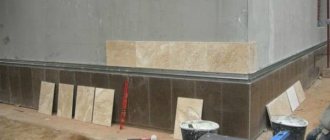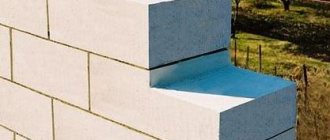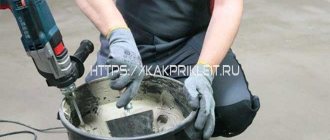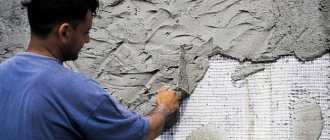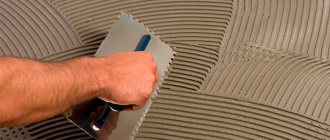Why is gypsum added to cement?
The main purpose of adding gypsum to cement is to slow down the hydration process of the cement after it is mixed with water. The process of cement hydration is that when water is added to cement, it begins to react with C3A and hardens.
Interesting materials:
How high should the bed be? How much laminate stock is needed when laying diagonally? What sign is 1997? Which zodiac sign is the luckiest? What is the procedure for calculating VAT when importing goods? What are the basic principles of accounting? What are the main responsibilities of a contract service? What clarity should I set on my TV? What date should I put in line 100 6 personal income tax? What kind of porridge can you eat for breakfast?
MK 900 Elastic tile adhesive based on white cement
| Photo: JSC Sievert Rus © |
Tile adhesive is a dry building mixture that is used for laying ceramic cladding, such as ceramic tiles and tiles, thick and thin porcelain tiles, artificial and natural stone, ceramic, stone and glass mosaics, on the base. The main task of tile adhesive is to ensure effective adhesion of the ceramic cladding to the base, to protect the base from environmental influences and loads, and at the same time ensure a beautiful appearance of the surface.
Due to the wide variety of ceramic cladding formats and different operating conditions of cladding coatings, the question of the quality of the tile adhesives used arises.
Today, in the Russian Federation, the characteristics of tile adhesives are regulated by the current regulatory document GOST R 56387-2018 “Dry adhesive mixtures based on cement binder. Technical conditions". This document regulates the following classes for tile adhesives: - CO - used for laying tiles with normal water absorption (at least 5% by weight) only for indoor work (only for ceramic tiles);
— C1 — used for interior and exterior work and complying with standard regulated requirements (for small and medium format ceramic cladding);
— C2 — used for interior and exterior work and meeting increased requirements (for any format of ceramic cladding).
Additionally, tile adhesives are assigned the following subclasses:
— F — quick-hardening adhesive mixtures:
- T - mixtures with increased resistance to slipping;
— E — mixtures with increased open time;
— S1—elastic adhesive mixtures;
— S2 — highly elastic mixtures.
The most effective tile adhesives for laying ceramic tiles are elastic and highly elastic adhesives of class C2, which can be used for laying all formats of tiles on the market, from glass mosaics to very large thin porcelain tiles.
brings to your attention high-quality tile adhesive based on white cement MK 900. This adhesive mixture in accordance with GOST R 56387-2018 has class C2 TE S1 - cement (C) meeting increased requirements (2) with increased resistance to slipping (T) with increased open time (E) elastic (S1).
The adhesive mixture MK 900 is used for laying ceramic tiles and porcelain stoneware, artificial and natural stone of medium and large formats, ceramic and glass mosaics, clinker tiles with the following cladding formats:
Glue it tightly. Let's talk about tile adhesive
If a recently laid tile breaks off, falls off, or “spreads apart,” the reason may be either the unprofessionalism of the craftsmen or low-quality materials: the tile itself, the covering of the walls or floor, and, of course, the composition on which the entire masonry is supported.
The durability of the laid tile and the possibility of laying it in principle largely depend on the type of glue and the correctness of its use.
My eyes are wide open! Why do you need so many varieties of tile adhesive?
A few decades ago, tiles were laid mainly on cement mortar. “Advanced” masters added their “secret ingredients” to it (glue in certain proportions, each tiler had his own recipe). Therefore, these days, when faced with repair work and the problem of choosing building materials, you can be surprised and confused, because stores offer a huge variety of tile adhesives from different companies and brands.
Understanding the nuances of the “adhesive assortment” is not difficult if you clearly understand:
- What kind of work is the adhesive intended for - external or internal? In the first case, the product must be “stronger”.
- You are going to glue tiles to the floor or walls. Theoretically, different compositions are used for these two surfaces, although for small home renovations this rule is not always followed.
- What size are you laying tiles and what is the scope of work? A small kitchen apron does not require any special expensive solutions (unless the design suffers), and the building to be covered will need “super-strong, moisture- and frost-resistant” glue.
- Under what conditions are the tiles supposed to be used: with high humidity in the bathroom; in the old foundation, where fungus spreads along the walls; in the open air (with a temperature of +40 °C in summer, when many synthetic substances melt, and in winter below −50 °C, when the same substances freeze and destroy). Or maybe they will not only walk on it, but sometimes drive over it?
- On what base will the tiles be laid? There are compositions that require a flat, well-primed surface, and there are adhesives that allow you to work without special preparation of the walls.
How to carry out external cladding in the cold season?
At temperatures below +5°C, cement hydration practically does not occur; ordinary tile adhesive freezes and does not adhere to the tiles. After the onset of a thaw, the tiles peel off.
Common challenges you may encounter
Didn't have time to finish the cladding
Sometimes some façade work cannot be completed during the warm period. Postponing them to spring is impossible for various reasons. Completion of begun facade work during the onset of frost requires the installation of a thermal circuit or heating with heat guns. The cost of work per square meter increases significantly.
The cladding is peeling off
When the weather gets warmer, the cladding, glued in the cold using conventional cement adhesives, peels off and comes off due to temperature changes.
Using the wrong materials in the cold
If you add salt to regular tile adhesive to protect against freezing, then at the end of the work, irremovable efflorescence will appear on the facade. Conventional mixtures in the cold have little plasticity, are difficult to apply and cannot be adjusted. Mixtures without frost-resistant additives in the cold have to be applied in a thicker layer than at normal temperatures. Therefore, glue consumption increases in the cold.
Solution
For external tiling work in the cold season, weber.vetonit ultra fix winter adhesive should be used. Work can be carried out at temperatures down to -10 ° C. Before use, the dry mixture, facing materials and base must have a temperature above 0 °C, the water for preparing the solution must be 7–20 °C. Do not use hot water (t≥35 °C)
Make sure that the base is not icy, frosted or covered with snow. Clean it from dust, dirt, old paint or plaster. Do not carry out work in strong wind, snow or rain.
How to prepare mortar for laying tiles?
Before any finishing work, it is necessary to determine with what composition the ceramic tiles will be molded to the base. Therefore, it is important to know how to prepare a solution for laying tiles?
There are two options: a cement-adhesive mixture is used as a lining layer, or modern dry admixtures with modified various additives
.
Cement-adhesive mixture
For cladding and for laying floors, the cement mortar is prepared in the same way. We recommend mixing solutions using coarse washed sand and cement no lower than version 300. The ratio of cement and sand particles in the final composition is necessary: 1:5 for cement version 300-400; about 1:6 with cement version 500-600.
To make the tiles hold tighter, you can mix 1/25 of PVA glue into the cement mortar prepared for work; the glue will improve the contact of the ceramic tiles with the wall and floor. The sand needs to be dry, or it will be very difficult to sow through a fine sieve. It is necessary to sift the sand, otherwise unnecessary particles will remain
: pieces of shells and small pebbles, pieces of clay mass. They will interfere with installation and if our tile is tapped to secure it properly, it will simply crack.
Correct mixing
The quality of the finished solution, as well as the completeness of the process, depend on the correctness of the procedure:
- Do not add water to the solution. In this case, many lumps appear that are difficult to stir. The actions should be reverse. First, water is poured into the container, then a little solution is added. It is advisable to use a mixer. The amount of water is chosen according to the manufacturer’s recommendation.
- The procedure of adding powder to water has another advantage. Not only is stirring faster, but it also creates 2 layers of solution. The top one is dense; consistency is assessed by it. The lower one is a little thinner, but it is brought to condition during the period that is spent on producing a solution from the surface.
Manufacturers of dry mixes emphasize that the solution should be mixed a second time. This is required not only to break up any lumps that have appeared, but also to restore consistency. The resulting composition sets quickly, but it must be left for the time indicated by the manufacturer (at least 5 minutes). And then the mixer is processed again. This is required to restore the consistency and maintain the properties of the solution for 20-60 minutes.
Types and characteristics of adhesive compositions
Modern manufacturers of building materials offer several types of mixtures intended for facing work. These include:
- universal adhesive - made on a cement base using additives that give the composition the necessary functional characteristics;
- reinforced – capable of reliably fixing heavy cladding elements;
- moisture resistant – suitable for finishing work in rooms where high levels of humidity remain;
- polymer - intended only for interior finishing work, as it does not tolerate temperature fluctuations and ultraviolet radiation;
- modified - a plastic mixture characterized by increased performance characteristics due to the addition of additives.
According to the method of preparation, all mixtures are divided into adhesive mastics and dry mixtures. Mastics do not require preliminary preparation - they are produced in the form of a paste, ready for use.
Tile adhesive
Why is tile adhesive better than cement and sand?
Sand cement consists of ordinary Portland cement and sand. Cement is used for masonry, while sand is usually river sand, in which grain size, purity and quality are difficult to control. Adhesive mixtures also contain additives that improve adhesion (adhesion to the surface), improve thixotropy (prevents sliding on vertical surfaces), plasticizers and other additives, in small doses, but if all this is added to the cement-sand mixture, then the price is will be equivalent, but you lose in quality and time, since in factories these additives are added to modern tile adhesive with high precision. Cheap tile adhesive adds fewer ingredients, but it is better than sand and cement.

